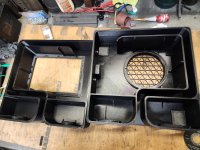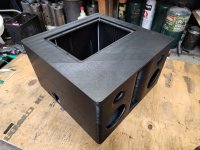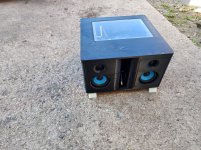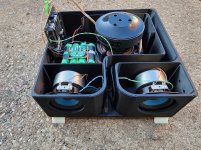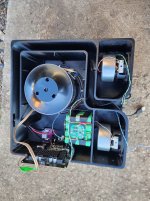A little while ago I built a 2.1 boombox and it sorta inspired me to make a "version 2.0" that will be more compact but hopefully just as capable, using the lessons learned from the first one and some more research.
My goals are for something not too heavy to carry (probably already ****** this up with my subwoofer driver choice, I had no idea it would weigh 7.5LB till it showed up, oops),
Reasonable battery life, and compact - hopefully around 0.5 cubic feet total or roughly 30x30x15CM/12"x12"x6".
To power it, I got this 4.1 DSP amp: http://manual.likeyou888.asia:8000/EX401.html, supposedly 50w x4 + 100W for the sub. I'm open to changing this out if there's something not insanely expensive that will outperform it. And I plan on putting a bigger heatsink on it, and probably placing it somewhere that it'll get some sort of airflow cooling from the subwoofer.
To power that, I'm building a 4s5p 18650 lithium battery, I did a bigger version of this before for my first boombox (4s10p) and it was super overkill. I think this should give it easily all-day listening at 3/4 volume. I have yet to charge my 4s10P version after 2 weeks of listening to my other boombox an hour or two a day.
For drivers, I've got the following:
Tweeters:FSA544010-1800
Midrange: FSA524030-3800
Both of these are made by Eastech and were in a fantastic 2.1 computer speaker system: https://www.ixbt.com/multimedia/corsair2500.shtml (review with info). I had these around already and really like how they sounded on my PC. The enclosure corsair put them in was 1.5L sealed per side, so I figured I'd just copy that.
For the subwoofer, I chose the Epique E150HE and the plan is a 8L (+/-1L) ported enclosure with a 6.5CM diameter port 46CM long, which I think I'll try and incorporate into a handle or something since 46CM is pretty long, but that's what WinISD comes up with for that driver.
I was planning on making the enclosure on a 3D printer, but I might actually make it out of plywood and lexan instead, just because I've got some and I do wonder how durable a 3D printed enclosure would be.
Questions, comments, ideas are welcome! And remember, I'm new at this, so if it seems like I'm overlooking something obvious, well, I probably am, please point it out!
My goals are for something not too heavy to carry (probably already ****** this up with my subwoofer driver choice, I had no idea it would weigh 7.5LB till it showed up, oops),
Reasonable battery life, and compact - hopefully around 0.5 cubic feet total or roughly 30x30x15CM/12"x12"x6".
To power it, I got this 4.1 DSP amp: http://manual.likeyou888.asia:8000/EX401.html, supposedly 50w x4 + 100W for the sub. I'm open to changing this out if there's something not insanely expensive that will outperform it. And I plan on putting a bigger heatsink on it, and probably placing it somewhere that it'll get some sort of airflow cooling from the subwoofer.
To power that, I'm building a 4s5p 18650 lithium battery, I did a bigger version of this before for my first boombox (4s10p) and it was super overkill. I think this should give it easily all-day listening at 3/4 volume. I have yet to charge my 4s10P version after 2 weeks of listening to my other boombox an hour or two a day.
For drivers, I've got the following:
Tweeters:FSA544010-1800
Midrange: FSA524030-3800
Both of these are made by Eastech and were in a fantastic 2.1 computer speaker system: https://www.ixbt.com/multimedia/corsair2500.shtml (review with info). I had these around already and really like how they sounded on my PC. The enclosure corsair put them in was 1.5L sealed per side, so I figured I'd just copy that.
For the subwoofer, I chose the Epique E150HE and the plan is a 8L (+/-1L) ported enclosure with a 6.5CM diameter port 46CM long, which I think I'll try and incorporate into a handle or something since 46CM is pretty long, but that's what WinISD comes up with for that driver.
I was planning on making the enclosure on a 3D printer, but I might actually make it out of plywood and lexan instead, just because I've got some and I do wonder how durable a 3D printed enclosure would be.
Questions, comments, ideas are welcome! And remember, I'm new at this, so if it seems like I'm overlooking something obvious, well, I probably am, please point it out!
I feel kinda bad recommending the E150HE. It's pretty much the best small sub you can find, but I didn't consider the weight. What's the largest single PR you could fit if you can't fit two E150HE-PRs? But of course go for the vent if you can fit it
Try a flared port to minimize length/volume occupied by port.But of course go for the vent if you can fit it
see my port geometry thread:
https://www.diyaudio.com/community/...sonance-absorbers-and-port-geometries.388264/
Main information for an optimized port in posts #591, 595, 616, 624, 646
Maybe I should add: if you want ask me anything, the thread is a mess ...Main information for an optimized port in posts #591, 595, 616, 624, 646
Try a flared port to minimize length/volume occupied by port.
see my port geometry thread:
https://www.diyaudio.com/community/...sonance-absorbers-and-port-geometries.388264/
Main information for an optimized port in posts #591, 595, 616, 624, 646
I'm likely going to 3D print the port. I am hoping I can 3d print the whole thing but fitting it in the build area of my printer might be a challenge.
I have not settled on a final layout yet since packaging this is... interesting.
I read through that thread and honestly have more questions than answers, most of it is over my head and I do have a few things I'm unsure about still - Am I correct in these basic assumptions?:
Chuffing is unlikely below 20m/sec, and flaring the ends of the port will make it less likely yet?
Port shape doesn't matter as long as the total port volume is the same as calculated? (so that 6.5CM round port 46CM long could also be any other shape that's 33.25cm^2 in area, the same length?)
minor alterations to port shape/volume or enclosure size should not dramatically affect performance? (so a 6.7CM port or 48CM long or going from a 10L to a 9.7L enclosure volume should have little effect) And making the enclosure larger will probably improve performance if all else is equal.
I intend on using this speaker in several environments - my old car that has no stereo, outdoors camping, possibly indoors at work sometimes. Probably the best locations for drivers would be the mids/tweeters on the front, the subwoofer on the bottom (with at least 1" air gap) and the subwoofer port on the front?
Last edited:
Yes, simplified that is correct.Chuffing is unlikely below 20m/sec, and flaring the ends of the port will make it less likely yet?
I'll post a calculation following my findings next!
No, you need to keep the port cross section surface / port length ratio for a specified tuning frequency (but you are correct that shape is mostly irrelevant).Port shape doesn't matter as long as the total port volume is the same as calculated? (so that 6.5CM round port 46CM long could also be any other shape that's 33.25cm^2 in area, the same length?)
Thus when increasing the diameter the length increases squared. That is getting difficult because of very long ports with high excursion low VAS drivers like the E150.
A 6,5 cm diameter port is very limiting for the capabilities of this woofer, leading to compression and chuffing. But with a dedicated geometry you can avoid these effects (up to a certain degree).
I will post an update later!
I did some simulation with hornresp and the flared port calculation formula.
The dayton E150 is a difficult (impossible?) driver for a vented enclosure!
here are my results so far:
you may consider:
The dayton E150 is a difficult (impossible?) driver for a vented enclosure!
here are my results so far:
- your proposed 8 liter enclosure is quite ok for this driver
- with your proposed port the tuning is a bit high, creating a ripple of some dB above the tuning frequency of 47 Hz
- for a max flat tuning the port length would need to be increased to 60cm
- the max velocity for your proposed port is around 24 m/s at 28 V input (equals 100 W with coils in series, just for this simulation) and should be OK accepting some compression at maximum level.
- the port flange diameter at both ends of the port should be min. 10 cm to reduce chuffing and compression (for a strouhal number of 1,5)
- considering flanges on both ends as mentioned above you probably need to increase its length (estimated + 10 cm)
- I would not suggest to include a curved wall gemoetry for this port, because it would increase length. instead I would use large roundover flanges (see radius above).
- the port lenght is difficult to include into the 8 liter enclosure so you probably need to fold it. making a slot port might be sensible.
- A long tube port should be stabilized (bracing) to avoid vibration.
- attention: there will be a port resonance with wavelength = 2 * port lenght = 226 Hz. this should be outside the speaker pass band.
you may consider:
- using passive radiator(s) instead of ports
- reducing the port cross section and accepting further reduction of max output SPL (which would be a pity for this woofer)
- using another driver
Ok, how's this look? That's
Should be ~8L NOT including the port volume. I need to check the math again but it's right about that. You don't include the port volume in the sizing, right? The chamber volume is separate?
I know I still need to add a flare at the one end. And do a bunch of other stuff. Like probably fix those corners more, etc.
Port internally is 20mm*153mm*600mm, which is roughly equivilent to a 64mm round port. (3216mm^2 for 64mm round, 3060 for this. ehh, pretty close. I could probably make that wall 1mm thinner to find those extra 200mm^2 if I need to.

Should be ~8L NOT including the port volume. I need to check the math again but it's right about that. You don't include the port volume in the sizing, right? The chamber volume is separate?
I know I still need to add a flare at the one end. And do a bunch of other stuff. Like probably fix those corners more, etc.
Port internally is 20mm*153mm*600mm, which is roughly equivilent to a 64mm round port. (3216mm^2 for 64mm round, 3060 for this. ehh, pretty close. I could probably make that wall 1mm thinner to find those extra 200mm^2 if I need to.
Last edited:
That could work, however the enclosure wall looks very thin (specially for such a powerful driver). Also the interior end of the port should be flanged as well.
The wall thickness is 6mm for most walls, 4mm for some.
Internal volume is only ~7L excluding the port, 9L including it. No way to make it bigger on my printer aside from going even taller, and it's already 3/4" taller than I was hoping it would need to be.
My DSP/amp and battery board showed up today, but the design is mostly finished. I still need to figure out a handle and feet. 1"/25mm should be tall enough for the subwoofer to work properly, right?

Internal volume is only ~7L excluding the port, 9L including it. No way to make it bigger on my printer aside from going even taller, and it's already 3/4" taller than I was hoping it would need to be.
My DSP/amp and battery board showed up today, but the design is mostly finished. I still need to figure out a handle and feet. 1"/25mm should be tall enough for the subwoofer to work properly, right?
well, life got in the way for a while, and this was a pain to print, but I got it, finally.
Should have it mostly assembled tomorrow, then I need to figure out how to tune the DSP/Amp thing I bought. I got it hooked up on the bench once but the subwoofer seems extremely quiet compared to the mids/highs, it was clearly not getting the same amount of output, but I'm sure there's just a setting in the software somewhere to fix that.
Should have it mostly assembled tomorrow, then I need to figure out how to tune the DSP/Amp thing I bought. I got it hooked up on the bench once but the subwoofer seems extremely quiet compared to the mids/highs, it was clearly not getting the same amount of output, but I'm sure there's just a setting in the software somewhere to fix that.
Attachments
The subwoofer fires down, do you have any feet or stand for the box? I mean, it looks like it fires into the table?
Ah, okay. That means it loses 6dB by no ground coupling and another ~4dB by not having a baffle step support (which is not realistic by such a type of speaker anyway). The spl of the sub is 83dB according to the data sheet.
83dB-6dB-4dB=73dB.
Your drivers for mid and high have (let's assume) 85dB. They are two each and each got their own power, so for the combined spl it's 85+3dB(doubling membrane surface)+3dB(doubling the power, as each side got its own power).
85+3+3dB=91dB!
So your sub is almost 20dB quieter than the other speakers. That means, your sub needs nearly about 100x the power of your mid-high drivers (well, give or take, just a very rough estimate).
Well, yes, it's supposed to be a lot quieter.
83dB-6dB-4dB=73dB.
Your drivers for mid and high have (let's assume) 85dB. They are two each and each got their own power, so for the combined spl it's 85+3dB(doubling membrane surface)+3dB(doubling the power, as each side got its own power).
85+3+3dB=91dB!
So your sub is almost 20dB quieter than the other speakers. That means, your sub needs nearly about 100x the power of your mid-high drivers (well, give or take, just a very rough estimate).
Well, yes, it's supposed to be a lot quieter.
Are you sure that's how it works?
Why is it not dramatically quieter when I hook it to a normal amp?
I know the subwoofer needs more power but I've never heard of needing 100 watts of subwoofer output to keep up with 1 watt of midrange.
My first design of an outdoor boom box also had similar from the ground spacing and seemed relatively balanced, output wise. If I cranked the output on the subwoofer of that the sub would easily overpower the mid/high drivers.
Why is it not dramatically quieter when I hook it to a normal amp?
I know the subwoofer needs more power but I've never heard of needing 100 watts of subwoofer output to keep up with 1 watt of midrange.
My first design of an outdoor boom box also had similar from the ground spacing and seemed relatively balanced, output wise. If I cranked the output on the subwoofer of that the sub would easily overpower the mid/high drivers.
Are you sure that's how it works?
Why is it not dramatically quieter when I hook it to a normal amp?
I know the subwoofer needs more power but I've never heard of needing 100 watts of subwoofer output to keep up with 1 watt of midrange.
In open air, that's how things go. Even with walls or even edges adding to the level, it's still 7dB lower.
My first design of an outdoor boom box also had similar from the ground spacing and seemed relatively balanced, output wise. If I cranked the output on the subwoofer of that the sub would easily overpower the mid/high drivers.
At your first design, the sub had over 90dB spl? I don't remember but I had in mind you had at least double the power for it than for the mid-high. Aside from that, the ventilation on the sub driver is blocked by your enclosure, that robs you of a few dB and leads to very early compression too.
Well, you were right - it was mostly the open air thing. As soon as I put it into the enclosure it woke right up. I had never tested the other one in open air, I thought you just meant with the spacing from the ground it was the problem.
Amazing how much of a difference the enclosure makes.
Now I need to figure out how to tune the DSP since it doesn't sound right, but it does sound "good enough" to prove the concept.
Amazing how much of a difference the enclosure makes.
Now I need to figure out how to tune the DSP since it doesn't sound right, but it does sound "good enough" to prove the concept.
- Home
- Loudspeakers
- Multi-Way
- Designing a small bluetooth boombox, here's where I've gotten so far, comments/criticism welcome
